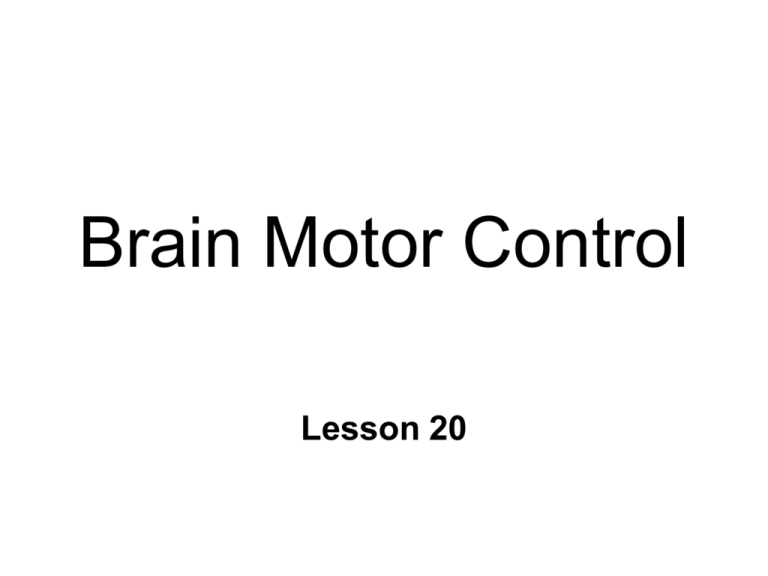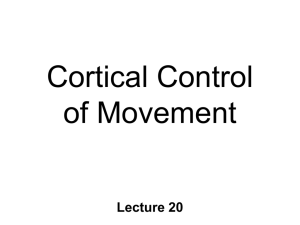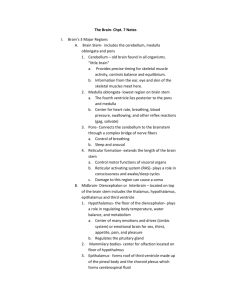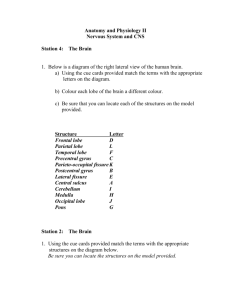Brain Motor Control
advertisement

Brain Motor Control Lesson 20 Hierarchical Control of Movement Association cortices & Basal Ganglia strategy : goals & planning based on integration of sensory info Motor cortex & cerebellum tactics: activation of motor programs Spinal cord execution: activation of alpha motor neurons ~ Sensorimotor Cortical System Integration of sensory information and directed movements Anatomy Descending spinal tracts Lateral pathway Pyramidal Motor System Ventromedial pathway Extrapyramidal pathway ~ SMA Cortical Anatomy M1 S1 PM S1 - postcentral gyrus PPC - Posterior Parietal Cortex M1 - Precentral Gyrus Frontal Lobe somatotopic organization M2 - Secondary Motor Cortex SMA - Supplementary Motor Area PM - Premotor Cortex ~ PPC Primary Motor Cortex Somatotopic organization neurons have preferred direction of movement Motor homunculus ~ M1: Coding Movement Movement for limbs Neuron most active Preferred direction but active at 45 from preferred How is direction determined? Populations of M1 neurons Net activity of neurons with different preferred directions vectors ~ M1: Coding Movement Implications 1. Most M1 active for every movement 2. Activity of each neuron 1 “vote” *all votes NOT equal 3. direction determined by averaging all votes ~ Motor Association Cortex Motor area other than M1 Premotor & Supplemental Motor Areas Active during preparation for movement Planning of movements Stimulation - complex movements motor programs Active during preparation for movement Planning of movements e.g. finger movements ~ Planning Movements Targeting vs trigger stimulus recording activity of neurons active when movement planned for specific direction Different populations of neurons active during planning (targeting) & execution (trigger stimulus) ~ Simple finger flexion only M1 activation Sequence of complex finger movements M1 + SMA activation ~ Mental rehearsal of finger movements only SMA activation ~ The Lateral Pathway Voluntary movement distal limbs Corticospinal (Pyramidal) tract Primary pathway (> 1 million neurons) Contralateral control movement Cortico-rubrospinal tract Via red nucleus But some recovery if damage to corticospinal ~ Spinal Cord: Lateral Pathway Dorsal Ventral Corticospinal tract Corticorubrospinal tract Motor Loops Cortex Subcortex Cortex Spinal cord Cerebellum coordination of movement Basal Ganglia selection & initiation of voluntary movements Parallel Processing ~ Motor Loop Through Cerebellum Lateral cerebellum simplest circuit 20 million axons Cortex pons & cerebellum Prefrontal, Motor, PPC Pons & Cerebellum thalamus VLc - ventrolateral nucleus VLc M1 lateral pathway ~ Prefrontal M2 Lateral Cerebellar Motor Loop M1 VLc Distal Limbs PPC Pons, Cerebellum Basal Ganglia Caudate nucleus Putamen Globus Pallidus Striatum Substantia Nigra Tegmentum Control slow movements Using immediate sensory feedback ~ Prefrontal Basal Ganglia M2 VLo M1 PPC Basal Ganglia Motor Loop Distal Limbs Parkinson’s Disease 1% of population Nigrostriatal pathway Substantia nigra neurons die Progressive loss Hypokinesia Rigidity Bradykinesia Akinesia ~ Cortex + Parkinson’s Disease + VA/VL Striatum X - + Substantia Nigra Direct Indirect - GPe - GPi + - Subthalamic Nucleus Parkinson’s Disease: Treatment Basal Ganglia - Cholinergic Substantia Nigra - Dopaminergic Drug Therapy L-DOPA Pallidectomy Tissue transplants ~ Huntington’s Disease (Chorea) Rare Genetic disorder Single dominant gene, chrom. 4 onset 30-40s Progressive disease Uncontrollable, jerky movements Dementia Degeneration of Striatum Caudate & Putamen GABA & ACh neurons ~ Cortex Direct Indirect + Huntington’s Disease + VA/VL Striatum - GPe - GPi - + + Substantia Nigra - Subthalamic Nucleus Huntington’s Disease: Cause HD gene huntingtin 3 forms mutated form binds to protein involved in energy production neuron starves Excitotoxicity contributes to degeneration glutamate Nitric oxide (NO) Potential treatment: Inhibit NO synthase ~








